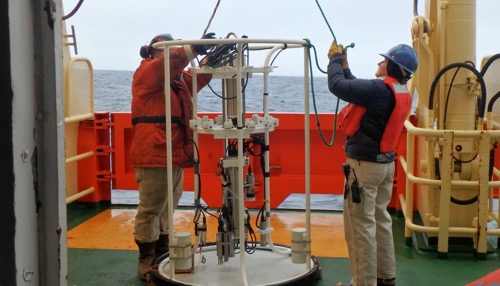Back in the Drake
We are officially back in the Drake PassageStrait, connecting the Atlantic and Pacific oceans between Tierra del Fuego and the South Shetland Islands. Located about 100 mi (160 km) north of the Antarctic Peninsula, it is 600 mi (1,000 km) wide.. After a week of little movement due to ice, everyone is getting reacquainted with life aboard a moving ship. After some last CTDA research tool that is submerged in the water to measure conductivity (salinity), temperature, and depth. casts to collect water samples, the process of dismantling and packing begins. When I woke up this morning, I realized that we are nearing the 60 degree south latitude line. This line generally designates the Antarctic zone. We are leaving Antarctica and have less than 400 miles to the tip of South America. The change in sunrise and sunset is already obvious and there are no ice chunks to remind us of the last few days. Whether I like it or not, the research cruise is nearing its end. Today's plan includes our last science sampling events and lots of packing - both sure signs that we are almost finished.
Squeeze in Some Science
Most of us thought that yesterday's deep trace metal CTDA research tool that is submerged in the water to measure conductivity (salinity), temperature, and depth. cast was the last sampling event of the cruise. But, like any research cruise plan, things changed. Timing worked in our favor to allow not only the deep trace metal cast, but a conventional CTDA research tool that is submerged in the water to measure conductivity (salinity), temperature, and depth. cast and an additional trace metal cast last night. This morning, two additional trace metal casts were completed to finish out our science sampling. In all, 64 CTDA research tool that is submerged in the water to measure conductivity (salinity), temperature, and depth. casts were completed over the duration of this research cruise.



The deep trace metal cast to 3500m/10500ft was used to generate a deep water profile for this area of the Drake PassageStrait, connecting the Atlantic and Pacific oceans between Tierra del Fuego and the South Shetland Islands. Located about 100 mi (160 km) north of the Antarctic Peninsula, it is 600 mi (1,000 km) wide.. The conventional CTDA research tool that is submerged in the water to measure conductivity (salinity), temperature, and depth. was used to collect water samples for molecular biology analysis. The three additional trace metal casts collected water samples just below the mixed layer. You may remember that the mixed layer is the layer where wind and waves mix the nutrients to enhance productivity in the photic (light) zone. Water was collected just below this area because the water does not need to contain high amounts of biomass. Once the water is filtered, it will be stored in large carboys and shipped back to the four research labs and used for two purposes:
Use the natural water of the Southern Ocean to maintain the diatom and bacterial cultures collected during this research cruise.
Use the natural water of the Southern Ocean to set up more incubation experiments using the cultured microorganisms (isolates) from this research cruise.
By collecting water from this area, the science team has the unique advantage of using ambient (natural) water conditions for both maintenance and experimentation. The science team could use sea water samples from other locations, however, these samples may not have the same chemical signatures as the water in the Southern Ocean.
Let the Packing Begin
With the water collection complete, the science team now begins the process of packing. Everything that was unpacked at the beginning of the research cruise must be inventoried, re-packaged and stored for shipment. In addition to the equipment, the science team must also inventory the samples that were collected over the past 5 weeks. Frozen water samples, frozen DNA/RNA samples and other water samples will be shipped to the laboratories when we arrive in Chile. With only a few hundred miles to go before we dock in Punta Arenas, the packing pace is sure to pick up.


Birthday Wishes
Wishing my cousin Sierra a very HAPPY 14TH BIRTHDAY! Have a great day!
Tomorrow's Journal
I don't normally give a preview of an upcoming journal, but I think tomorrow's will be exciting to read. During the research cruise, the science team had an opportunity to leave the ship. Curious?? Find out more in tomorrow's journal. I have been waiting to write this journal for some time - kind of like I saved the best for last.


Comments